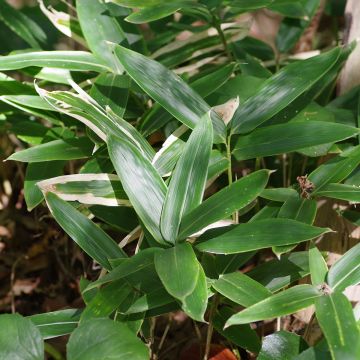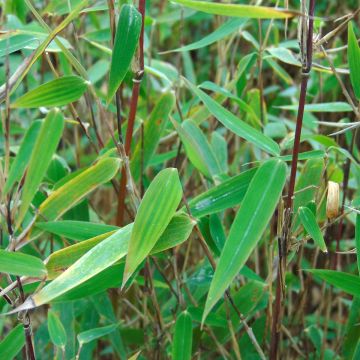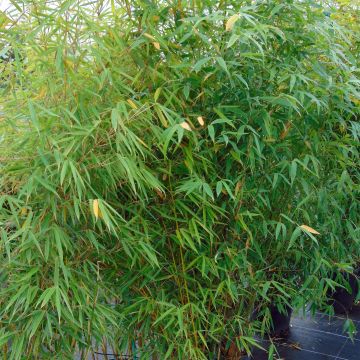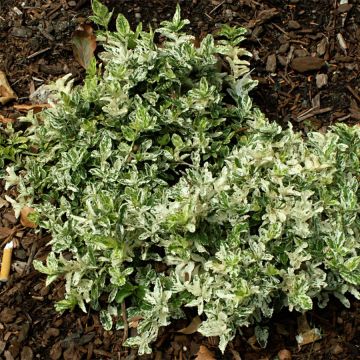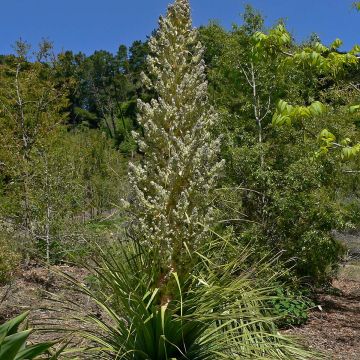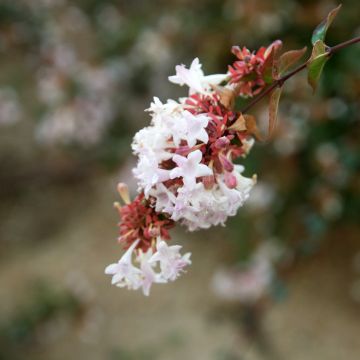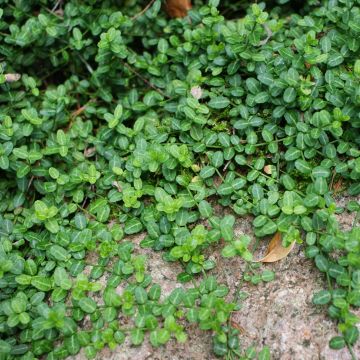

Pleioblastus linearis - Bambou moyen
Pleioblastus linearis
Pleioblastus linearis
This item cannot be shipped to the selected country
Delivery charge from €5.90
More information
Schedule delivery date,
and select date in basket
This plant carries a 24 months recovery warranty
More information
We guarantee the quality of our plants for a full growing cycle, and will replace at our expense any plant that fails to recover under normal climatic and planting conditions.
From €5.90 for pickup delivery and €6.90 for home delivery
Express home delivery from €8.90.
Does this plant fit my garden?
Set up your Plantfit profile →
Description
Bamboo Pleioblastus linearis, with its giant display and its long, grass-like leaves reminds us, more than any other, that bamboo is actually a type of grass. It is of medium size and grows in a similar way to Fargesia, with its canes tightly packed together from a compact stump. Like them, it has dense and evergreen foliage arranged in beautiful, slightly trailing plumes. Infinitely graceful, extremely decorative, and cold-resistant, this lesser-known bamboo deserves to be planted more and celebrated in our gardens!
Pleioblastus linearis is a bamboo that is perfectly adapted to our temperate climates. It originates from the south of Japan, specifically the Ryukyu Islands, and belongs to the large grass family Poaceae. This bamboo has very closely spaced culms (or canes), with a diameter of 2 to 3 cm (1in), which typically reach a height of 3 to 6 m (10 to 20ft). It spreads fairly slowly in width through its rhizomes. These rootstocks are characterised by short necks and develop a large number of tightly packed canes. However, underground, they sometimes spread over long distances. Regular pruning allows it to take on the appearance of a beautiful umbrella-shaped tree, reminiscent of a vine-plant but larger. Eventually, this bamboo, through its foliage and canes, forms a dense, almost impenetrable, mass, . Its evergreen foliage is flexible, very dense, and particularly delicate. It consists of very narrow leaves, measuring 10 to 25 cm (4 to 10in) in length and 8 mm (1in) to 1 cm (1in) in width, which are a beautiful bright green colour.
Hardy and vigorous, this bamboo thrives in full sun or partial shade, in deep and moist soil, preferably with little limestone. This little-known and little-planted Pleioblastus is one of the most graceful bamboo species, especially when the wind plays with its foliage as it does with that of tall grasses. Although it is generally not invasive, we still recommend containing its growth by using a bamboo root barrier or, alternatively, allowing it to spread in a large mass at the edge of your garden. Its habit works wonders in a Japanese garden, whether it is zen-inspired, wild, exotic, or contemporary. It can create splendid, highly opaque screens as well as impenetrable hedges. It can also be grown in containers, as long as it is repotted every year and the older canes are regularly removed to make room for new shoots.
Report an error about the product description
Pleioblastus linearis in pictures


Plant habit
Foliage
Botanical data
Pleioblastus
linearis
Gramineae
East Asia
Other Bamboos
Planting and care
Pleioblastus linearis is a bamboo that prefers sun or partial shade. It requires a deep, fertile, preferably moist soil, that is acidic to neutral, at least without excess limestone. It should preferably be planted in late summer or autumn, or even in spring. Although not invasive, it is still advisable, during planting, to install a bamboo root barrier to limit its spread. It can tolerate temperatures as low as -15°C (5°F), regrowing from the stump when the foliage has been burned by the cold. In the ground, it dislikes overly dry situations as well as prolonged periods of drought.
For pot cultivation, use well-draining potting compost and provide organic fertilizer twice a year to prevent yellowing of the leaves due to excess water and lack of nutrients. Repot this bamboo every year and remove the oldest canes to make room for the young shoots.
Propagation can be done through rhizome cuttings or clump division. This bamboo can be pruned every year in early spring, to encourage the development of new foliage or to give it a particular shape.
Planting period
Intended location
Care
This item has not been reviewed yet - be the first to leave a review about it.
Evergreen shrubs
Haven't found what you were looking for?
Hardiness is the lowest winter temperature a plant can endure without suffering serious damage or even dying. However, hardiness is affected by location (a sheltered area, such as a patio), protection (winter cover) and soil type (hardiness is improved by well-drained soil).

Photo Sharing Terms & Conditions
In order to encourage gardeners to interact and share their experiences, Promesse de fleurs offers various media enabling content to be uploaded onto its Site - in particular via the ‘Photo sharing’ module.
The User agrees to refrain from:
- Posting any content that is illegal, prejudicial, insulting, racist, inciteful to hatred, revisionist, contrary to public decency, that infringes on privacy or on the privacy rights of third parties, in particular the publicity rights of persons and goods, intellectual property rights, or the right to privacy.
- Submitting content on behalf of a third party;
- Impersonate the identity of a third party and/or publish any personal information about a third party;
In general, the User undertakes to refrain from any unethical behaviour.
All Content (in particular text, comments, files, images, photos, videos, creative works, etc.), which may be subject to property or intellectual property rights, image or other private rights, shall remain the property of the User, subject to the limited rights granted by the terms of the licence granted by Promesse de fleurs as stated below. Users are at liberty to publish or not to publish such Content on the Site, notably via the ‘Photo Sharing’ facility, and accept that this Content shall be made public and freely accessible, notably on the Internet.
Users further acknowledge, undertake to have ,and guarantee that they hold all necessary rights and permissions to publish such material on the Site, in particular with regard to the legislation in force pertaining to any privacy, property, intellectual property, image, or contractual rights, or rights of any other nature. By publishing such Content on the Site, Users acknowledge accepting full liability as publishers of the Content within the meaning of the law, and grant Promesse de fleurs, free of charge, an inclusive, worldwide licence for the said Content for the entire duration of its publication, including all reproduction, representation, up/downloading, displaying, performing, transmission, and storage rights.
Users also grant permission for their name to be linked to the Content and accept that this link may not always be made available.
By engaging in posting material, Users consent to their Content becoming automatically accessible on the Internet, in particular on other sites and/or blogs and/or web pages of the Promesse de fleurs site, including in particular social pages and the Promesse de fleurs catalogue.
Users may secure the removal of entrusted content free of charge by issuing a simple request via our contact form.
The flowering period indicated on our website applies to countries and regions located in USDA zone 8 (France, the United Kingdom, Ireland, the Netherlands, etc.)
It will vary according to where you live:
- In zones 9 to 10 (Italy, Spain, Greece, etc.), flowering will occur about 2 to 4 weeks earlier.
- In zones 6 to 7 (Germany, Poland, Slovenia, and lower mountainous regions), flowering will be delayed by 2 to 3 weeks.
- In zone 5 (Central Europe, Scandinavia), blooming will be delayed by 3 to 5 weeks.
In temperate climates, pruning of spring-flowering shrubs (forsythia, spireas, etc.) should be done just after flowering.
Pruning of summer-flowering shrubs (Indian Lilac, Perovskia, etc.) can be done in winter or spring.
In cold regions as well as with frost-sensitive plants, avoid pruning too early when severe frosts may still occur.
The planting period indicated on our website applies to countries and regions located in USDA zone 8 (France, United Kingdom, Ireland, Netherlands).
It will vary according to where you live:
- In Mediterranean zones (Marseille, Madrid, Milan, etc.), autumn and winter are the best planting periods.
- In continental zones (Strasbourg, Munich, Vienna, etc.), delay planting by 2 to 3 weeks in spring and bring it forward by 2 to 4 weeks in autumn.
- In mountainous regions (the Alps, Pyrenees, Carpathians, etc.), it is best to plant in late spring (May-June) or late summer (August-September).
The harvesting period indicated on our website applies to countries and regions in USDA zone 8 (France, England, Ireland, the Netherlands).
In colder areas (Scandinavia, Poland, Austria...) fruit and vegetable harvests are likely to be delayed by 3-4 weeks.
In warmer areas (Italy, Spain, Greece, etc.), harvesting will probably take place earlier, depending on weather conditions.
The sowing periods indicated on our website apply to countries and regions within USDA Zone 8 (France, UK, Ireland, Netherlands).
In colder areas (Scandinavia, Poland, Austria...), delay any outdoor sowing by 3-4 weeks, or sow under glass.
In warmer climes (Italy, Spain, Greece, etc.), bring outdoor sowing forward by a few weeks.




































